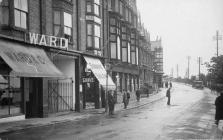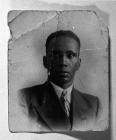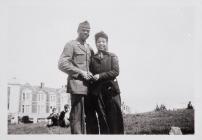Multicultural Barry and Wales' First Black Mayor
Items in this story:
Barry's BAME history goes back to the opening of Barry Docks in the 1880s and to the dozens of businesses that grew in and around the area. The Docks opened for trade in 1889, and by 1913 it had overtaken Cardiff as the largest exporting port in the country. In the years that followed, merchant seamen from places such as the Cape Verde Islands, Somalia and Greece settled in Barry as well as from other parts of the UK. Indeed, the construction of the Docks saw Barry's population grew from a little under a hundred inhabitants to 3,800 in less than 20 years. The 1901 census shows that the residents of Travis Street, for example, came from all over the world, including Tobago, Barbados and Jamaica, Denmark and Holland, Greece, Spain and Africa, with many mixed race marriages.
1919 Race Riots
Ports such as Liverpool and Cardiff deteriorated following the First World War, and there was widespread unemployment among seamen. Lack of work and social tensions led to race riots in Barry, as in Newport and Cardiff. In June 1919, the riots began to take hold in Barry and black people - and women who were married to black husbands - suffered attacks on their property. There was strong opposition among some factions to the presence of black seamen in these communities, not only because of lack of jobs, but also because they married white girls. One incident that resulted in significant turbulence was a fight between a former soldier named Frank Longman, and Charles Emanuel, a seaman from the Caribbean. Longman was stabbed and Emanuel subsequently sentenced to five years' imprisonment for manslaughter. Although no other deaths occurred as a result, there was plenty of tension and disagreement. There were newspaper reports about gangs of up to 50 people marching to Holton Road, congregating outside the chip shop, and had it not been for the rapid response of the police, the attack on the shop - and their owners - would have been serious.
An attempt was made by the government of the day to calm the waters in the wake of the racist riots by sending as many black sailors as possible back to their home countries; this policy continued into the early years of the 1920s, but not everyone wanted a one-way ticket home. For many, the race riots came at a pivotal time as a number of black men chose to stay with their new families in Wales. Their descendants' roots run deep, and they continue not only to contribute to their communities in Barry but to lead them.
John Darwin Hinds, Wales' First Black Mayor
One seaman who turned his back on the sea and went to work in the coal mines was Leonard Hinds. He came over to Barry from Barbados. He married Gwenllian Lloyd, originally from Cardiff, and they had six children. One of them was John Darwin Hinds, the first black county councillor in Barry Town Council, and indeed, in Wales. In the 1960s he was elected Mayor by Glamorgan County Council, and as he had converted to Islam he also became the first Muslim in Britain to hold these positions.












